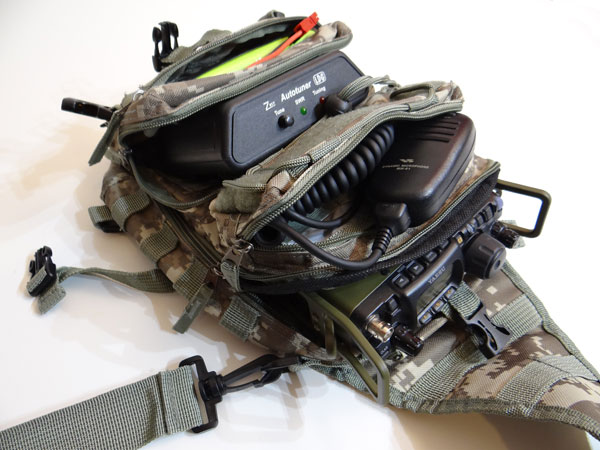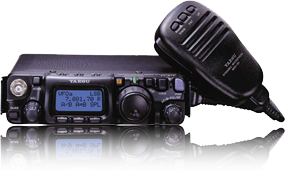"MY ALIGATOR IS SWEET, MY DOLLY IS BENT, AND I HAVE CHOKED MY PARROT!"
Introduction
No, that isn't a joke from a Monty Python movie, its a coded message that might be used by a US Navy fighter pilot. "Aligator" and "Dolly" refer to two on board systems, and "sweet" and "bent" means that one is working well, while the other is actually broken. The final portion is informing the listener that the pilot has turned off his IFF (Identification Friend or Foe) system, aka the Parrot, which automatically squawks an ID number, hence he has choked it!
Fortunately, ground forces radio work is a little less influenced by the likes of
Tex Avery
and
Chuck Jones
, the creators of Bugs Bunny, Daffy Duck and Wile E. Coyote, all popular mascots in the UNSGC.

Above: ICOM IC-F29DR dPMR446
|
This and the following pages carries a basic guide to NATO standard voice radio procedures, complete with lists of the special words and phrases known as Prowords, the reporting code for the signal strength and readability of another stations transmissions, a page on Authentication Codes, one on Message Precedence,
an finally a description of the 3 radio bands, planned for use by the UNMC (UNSGC). This includes details of the 8 analogue and 16 digital Public Mobile Radio (PMR) frequencies used by off-world teams, for Marine to Marine communications.
There is one other vital page; this deals with a "code" that everyone must memorise, that is the standard NATO Phonetic Alphabet, even if not actually an RTO (Radio Telephony Operator). During day to day verbal, and/or radio/telephone communications it is in constant usage for unit ID and "CALL SIGNS", and where necessary for spelling out a word or words. It is vital even in normal conditions never mind when a signal is poor, or under the stress or noise of combat. Messages can become easily garbled, and so a clearer method of denoting letters and numbers is essential. The standard system used throughout the US and allied military services including the UNMC is the so-called International system formalised and adopted by NATO in 1956. For the full NATO Phonetic Code click the link to Part 4 at the top of the page.
You will also find a great deal of useful material on the
UNMC Abbreviations, Acronyms & Glossary of Terms
pages.
For those training to serve as RTO's, there is a specific resources page for you
HERE.
Finally, there are two unofficial codes in military service designed to enable on-air profanity, which is otherwise proscribed by the authorities. If you think you maybe offended by such material, then please avoid this article, if not then go to
The Profanity Codes.
Equipment
The following notes can be applied to any kind of field deployable communications equipment, from the small 500mW tactical radio, operating in the UHF band at around 446MHz, through to
10W mullti-band backpacks (aka "portable"), covering HF, VHF and UHF frequencies. To a limited degree in can also be applied to vehicle mounted mobile or base station equipment as well.
Today tactical radio equipment is compact, lightweight and simple to use.
Your radio will need the following features and accessories:
|
-
The basic radio should be the best you can afford. The best radios satisfy IP67, meaning that they are fully dustproof and submersible to 1 metre for up to 30 minutes. The new dPMR (digital Public Mobile Radios) give the best performance, clarity and range, and have a larger number of frequencies and privacy codes. Plus they tend to be backwards compatible with the older analogue radios. See the details of new
ICOM IC-F29DR radio as pictured above as an example.
Alternatively, if you are an RTO, try the tri-band, multi-mode
Yaesu FT-817ND
'portable' pictured below.
-
A large battery compartment, normally at the back or on the bottom, usually taking several batteries or a special rechargeble pack. A spare set should always be carried in the field. It is remarkable how many people's fresh batteries, aren't!
-
An antenna, aka an aerial, usually of the rubber coated coil (helical) type, which will bend rather than break when pushed against. NB: the antenna of PMR446 (Private Mobile Radios in the 446MHZ range) are required to be legally non removable. Qualified RTO'S will have their choice of antenna, but some kind of whip, will no doubt be the most common.
-
An on/off control (sometimes combined with the volume control).
-
A separate volume control, if not combined with the on/off switch.
-
A channel selector. Some PMR446 radios give you the full range of 24 frequencies and 38 analogue and 104 digital privacy codes, which equates to 1,968 separate channels. These tend to be fiddly to use in the field, while the more expensive models are programmable in-base, with a single simple channel selector providing easier access to somewhere between 4 and 16 pre-selected channels. Newer models also have audio announcements of the channel when selected, useful.
|
<

Above: the Yaesu FT-817ND in a Sierra Pack in arid digi-cam, a 5 Watt multi-mode, multi-band HF, VHF and UHF 'portable' radio.
Click the image to see the specifications

Above: the Yaesu FT-817ND radio by itself, just with a microphone-speaker plugged in.
Click the image to see the specifications
|
-
An earphone/headset socket (optional, but recommended)
-
a microphone socket (optional, but recommended)
-
A Push-To-Talk (PTT) button. Separate ones are recommended.
-
A speaker. If the volume is kept low, the noise from a speaker will not travel very far, and so their use is not as unsafe as you might imagine. However, many operatives prefer the guaranteed security of an ear bud or headset.
-
A squelch control. This otherwise useful feature is on modern radios normally automated. It allows you to set the sensitivity of your radio and reduce the amount of hiss you hear when no signal is being recieved. This can be turned down, so that the weakest signal can be picked up and heard. The downside is then that you have a constant hissing in your ear, but then that is better than a missed message. This does not apply to digital radios because of the way they work. Even the weakest signal is reproduced perfectly, however if the signal is too weak, the radio "falls off the digital cliffe" and you will hear nothing, but then again you would have heard even less with an analogue radio. The larger multi-band, multi-mode radios will probably have both a manual and an automatic squelch.
-
A display, not always present or as useful as you might think. On some radios the controls themselves serve to "display" things like the current channel. Displays will normally give a number of read-outs, channel, signal strength (S meter) and a wide range of other functions, most of which tend to be unnecessary in field use. Displays are often fitted with a back light for night use, which should only be used when there is no risk of betraying your position. The key downside of displays is that they tend not to be as waterproof or tactically secure. Again, backpack radios are housed in such a way, that the display is usually adequately protected, but unless you are equiped with a separate hand held controller, you will need to dismount the pack to gain access.
-
An ear-bud, headset or hand mic are optional, but many use them to prevent eccessive noise. Noise cancelling headsets and mics and external pick-ups are especially desireable, if somewhat expensive.
-
A secure cover, pouch or pack, which can be attached to your vest or webbing, or carried independently. This will protect your radio from impacts, the effects of rain, and prevent loss. It should be positioned for ease of access. For example, for a personal radio, just below the left shoulder (right handed users), thus avoiding interference with shouldering your weapon. Do NOT use belt clips or the like, you will lose your radio. Ideally you should be able to use it without removing the radio from its pouch. Alternatively, if you plan to use a headset and separate Push-To-Talk (PTT) button, then the radio can be mounted on the back of your kit. Ideally in either case you should mount it as high as you can and as far away from your face and head as is practicable. Specialist radio backpacks are available, with numerous compartments and cabling ducts, to take ground mounted antenna, spare batteries, SWR meters and other kit.
-
Finally, you should always carry a notebook and pencil/pen to store useful reminders, and to write down or compose messages. This is not the same as your battlebook, the notebook is a potentially disposable item of kit. This notebook should ideally come with waterproof paper. A pen with a pressurised cartridge, such as those made by Fisher, are excellent. The latter permits writing even when lying on your back. Pens or pencils can be provided with lanyards to prevent loss, but a back up is always a good idea. An admin pouch is useful to keep, pens, pencils and notebooks in, and can be vital for storing one time Authentication Code sheets, see
Part 6. It should be kept securely, where it can be easily and quickly reached, but not lost. The notebook and code sheet should be destroyed in the event of possible hostile capture. Likewise obtaining enemy notebooks can prove to be key items of intelligence.
NB: Some radios have what is called VOX,or a Voice Operated Transmission option. This enables the radio to automatically transmit when the operator speaks, without the need to use any controls. Although this sounds like a good idea, it is not, as the radio will transmit with the least provocation. Even gunfire will activate it. This will jam the frequency and prevent you from recieving critical messages. Also some radios have an automatic tone signal that may send a loud beep out when you press and or release the PTT. Turn these features off they get people killed.
End of Document
|




